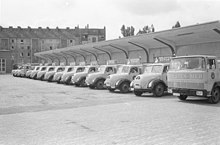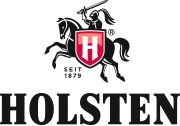Holsten Brewery
| Holsten Brewery AG
|
|
|---|---|
| legal form | Corporation |
| founding | May 24, 1879 |
| Seat | Hamburg , Germany |
| management | Sebastian Holtz (CEO) |
| Number of employees | 650 (2018) |
| sales | 105 million euros (2011) |
| Branch | brewery |
| Website | www.holsten-pilsener.de |



The Holsten-Brauerei AG is a 1879 in the then- Holstein town of Altona (Elbe) based brewer . It has belonged to Carlsberg A / S since 2004 and has its administrative headquarters in today's Hamburg district of Altona-Nord on Holstenstrasse and its brewery in Hamburg-Hausbruch .
history
About a year after the founding meeting on May 24, 1879, the first brew was made in the Holsten brewery . The first tasting of the Holsten beer took place on May 6, 1880. Even then, a knight on a horse served as a trademark - the Holsten logo. For the first 25 years, Holsten beer was mainly sold on the local market (Altona and Hamburg) and quickly became the leading beer manufacturer in the Hamburg area. Holsten also began exporting beer as early as 1881 and in 1903 set up a branch in Wandsworth near London called "The Holsten Brewery Ltd.".
Furthermore, Holsten tried to consolidate his local market position in the years to come and continued his expansion on a regional level by taking over other breweries: in 1909 the A. Janssen Brewery was taken over, followed by the club brewery with its export brand " Bergedorf Beer" in 1914 the First world war the brewery Germania in Wandsbek , the mountain brewery Steinbek (1918) and the Civil brewery in Eilbek (1920). In 1922 the DH Hinselmann brewery, in 1923 the Boës & Berghoff brewery (both in Neumünster ), and in 1924 the Kieler Schloss-Schifferer-Brauerei were taken over.
During the Second World War , all three production facilities in Hamburg, Neumünster and Kiel were largely destroyed and rebuilt after the war as part of a fundamental modernization. In 1952, Holsten introduced beer in cans as an innovative innovation . In 1954, Holsten acquired a majority stake in the Bremen Germania brewery C. Dressler and was therefore not only present in the Schleswig-Holstein and Hamburg area, but also in Lower Saxony and Bremen .
From the post-war period, not only in the Hamburg area to the present day, come common, tongue-in-cheek pub proverbs: "Holsten Edel is my girl", "Holsten bangs the hardest" and "Holsten Edel bangs in 'skull" are signs of close customer loyalty to the main product the brewery. In addition, the term "Hopihalido" (is Ho lsten Pi lsener Ha lbe- Li ter Thu s) by the song "cans of beer makes clever" the band Illegal 2001 and by Lotto King Karl the winged word become.
Today's Holsten-Brauerei AG is formally a new company founded in 2014. In the same year , the original AG merged with another German Carlsberg subsidiary.
Further stations in the company's history
- 1954: Takeover of the majority stake in the Dreßler brewery in Bremen
- 1956: Takeover of Bill-Brauerei AG (Moravia Pils)
- 1957: Strengthening of the UK business
- 1960: Foundation of the Hansa Mineralbrunnen GmbH
- 1960s: Takeover of the Dannenberger (Elbe) "Windels" brewery and immediate closure, only the "Windels Doppelkorn" brand was continued for a few years. Finally in Lüneburg .
- 1970: Participation in Kaiser-Brauerei AG in Hanover
- 1972: majority stake in Kaiser-Brauerei AG Hannover
- 1974: Participation in the Kronen Brewery in Lüneburg
- 1976: Entry into the Feldschlößchen AG brewery in Braunschweig
- 1981: Incorporation of the Feldschlößchen AG brewery
- 1986: Closure of the Neumünster branch of the Holsten brewery
- 1988: Presentation of beer brands such as Duckstein
- 1991: Takeover of today's Mecklenburg Brewery Lübz , Lübz ( Mecklenburg )
- 1991: Holsten begins to brew and sell Foster’s under license
- 1992: Takeover of Sächsische Brau-Union GmbH, which has been operating under the traditional name "Feldschlößchen" since 1995
- 1994: Closure of the Kiel branch of the Holsten brewery
- 1998: Takeover of the Bavaria-St.Pauli-Brauerei ( Astra (beer) )
- 1999: Entry into the Hessian Licher private brewery Jhring-Melchior GmbH & Co. KG
- 2000: Acquisition of the König brewery (König Pilsener) in Duisburg
- 2001: Closure of the Lüneburger Kronenbrauerei branch in Lüneburg with simultaneous relocation of the production of Moravia Pils to Hamburg and the abandonment of the production of Lüneburg Pilsener in swing-top bottles
- 2003–2006: The Landskron brewery in Görlitz belongs temporarily to Holsten
- 2011: Lüneburger Pilsener is again sold in a box (24 / 0.33 l longneck)
More recent developments
The acquisitions of the last few years marked the attempt to maintain independence in the face of the enormous concentration processes in this branch on the national and international markets. The management did not always have a lucky hand, but sometimes competed with the premium brands it had bought itself. Against all warnings from some shareholders, the Holsten board of management insisted that beer sales in cans and PET bottles would continue to rise despite the foreseeable introduction of a deposit for one-way packaging (2003) and even expanded its corresponding filling capacities. This corporate strategy failed: Holsten-Brauerei AG has been a subsidiary of the Carlsberg Brewery since 2004 . In the run-up to the takeover, the latter had agreed with the Bitburger brewery to sell the stake in the Licher private brewery and the König brewery to them. In addition, the remaining Holsten shares remaining in free float were bought up in 2005 ( squeeze-out procedure, a forced sale permitted by stock corporation law). In 2005, Holsten-Brauerei AG took over the beverage wholesaler Göttsche Getränke in Hamburg.
In 2006 the Landskron brewery was also sold. In 2009 Holsten sold the brewery in Braunschweig to Oettinger . On January 1, 2011, Holsten sold the brewery in Dresden to Frankfurter Brauhaus GmbH, including all rights to the Feldschlößchen brand. Holsten now only has two locations in Germany (Hamburg and Lübz) and sells eight brands (Holsten, Carlsberg, Astra, Duckstein, Lübzer, Grenzquell, Moravia and Lüneburger).
The Holsten Brewery Festival has been held annually on the brewery's outdoor area since 2011 .
At the beginning of 2016, Carlsberg announced that the production of the beer would be relocated from Altona-Nord to Hausbruch in 2019 . The property of the brewery in Altona-Nord is to be used for residential construction. On November 4, 2019, the new production facility went into operation.
Key figures
2003
- Beverage sales: 12.9 million hectoliters
- Of which beer: 9.1 million hectoliters
- Non-alcoholic drinks : 3.8 million hectoliters
- Number of employees (annual average): 2840
- Beer sector: 2571
- Non-alcoholic drinks area: 269
- Sales excluding beer tax : EUR 752.091 million
2005
- Beverage sales: 6.8 million hectoliters
- Number of employees (annual average): 1523
- Sales without beer tax: 361.8 million euros
2020
- Number of employees (production only): 190
- 80 percent are bottled, the remaining 20 percent in barrels
Products
Holsten produces the following beers, among others:
- Holsten Pilsener (alc. 4.8% vol.)
- Holsten alcohol-free
- Holsten Export (alc. 5.2% vol.)
- Holsten Bernstein Lager (alc. 4.6% vol.)
- Holsten Extra Herb (alc. 5.0% vol.)
- Holsten Edel (alc. 4.9% vol.)
- Holsten Brauwelt Pale Ale (alc. 5.9% vol.)
- Holsten Brauwelt Märzen (alc. 5.5% vol.)
- Holsten Brauwelt Rotklinker Brown Ale (alc. 6.1% vol.)
- Astra Urtyp (alc. 4.9% vol.)
- Astra red light (alc. 6.0% vol.)
- Astra Kiezmische (alc. 2.5% vol.)
- Astra rocket (alc. 5.9% vol.)
- Grenzquell Pilsner (alc. 4.9% vol.)
- Lüneburg Pilsener (alc. 4.9% vol.)
- Moravia Pils (alc. 4.9% vol.)
See also
Web links
- Holsten Brewery AG Hamburg
- Holsten International (English)
- Early documents and newspaper articles on the Holsten Brewery in the 20th Century press kit of the ZBW - Leibniz Information Center for Economics .
- Lüneburger Kronenbrauerei - private website
Individual evidence
- ^ Jana Werner: Holsten Brewery: Fronts between Carlsberg and employees hardened . In: THE WORLD . December 13, 2017 ( welt.de [accessed July 2, 2018]).
- ↑ n-tv news: Carlsberg takes over Holsten . In: n-tv.de . ( n-tv.de [accessed on July 2, 2018]).
- ↑ Beer Primer »Blog Archive» Holsten Brewery. Retrieved on July 2, 2018 (German).
- ^ Shares and historical securities History of the Holsten Brewery. Archived from the original on July 2, 2018 ; accessed on July 2, 2018 .
- ^ Alfred Brändel: Bergedorf Beer . In: Lichtwark No. 18. Ed. Lichtwark Committee, Bergedorf, 1959. See now: Verlag HB-Werbung, Hamburg-Bergedorf. ISSN 1862-3549 .
- ↑ Holsten Brewery is moving around in 2018 welt.de, February 11, 2016
- ↑ Andreas Göhring: Holsten: Order for a new brewery building in Hausbruch was placed. In: harburg-aktuell.de. September 29, 2017. Retrieved September 29, 2017 .
- ↑ "Holsten Brewery starts operations in Hausbruch" NDR.de, November 4, 2019
- ↑ welt.de of July 4, 2020
Coordinates: 53 ° 33 ′ 41 ″ N , 9 ° 56 ′ 35 ″ E







